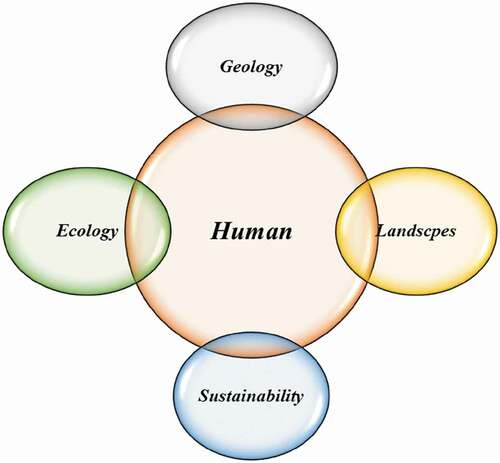Landscape evolution studies have been taken the interest of different scholars from different perspective-ecology, geology, and many other disciplines. Earth’s landscape is shaped by the interaction between tectonics and climate (Patil et al., Citation2019). This simple statement manifested that in principle it is acceptable to consider both tectonic rates and variation in climate regimes as a key factor for the dynamic interface (Earth’s surface) (D’Agata et al., Citation2020; Whittaker, Citation2012). Similarly, landscape ecology is mainly focused on the interplay among spatial patterns and ecological processes. More precisely, landscape ecology involves the expansion and dynamics of spatial heterogeneity as well as their effects on the biotic and abiotic process (Turner & Gardner, Citation2015). Besides, landscape ecology is sometimes taken as a multidisciplinary science deals with “built” environments, in which humans play the main role behind landscape change (Çelik, Citation2013).
Landscape could be found everywhere, and it is considered an essential element for quality life, which assists in the addition of local cultures. There are different processes including physical, chemical, and biological routes acting across the landscape that participate in the movement of particulate sediments and solute from source to sink through the sediment-routing system (Allen, Citation2008). It is also endorsed that both erosional and depositional landscapes are connected with the sediment-routing system. The physical features of the landscape need proper consideration for both scientifically and from a management perspective ().
With the rapid population expansion, the increasing demand for commodities and services from the global ecosystem has become a cause of the various ecological dilemmas. The evidence of ecosystem limits could be seen in the form of altered flooding regimes, remarkable abatement of thousands of species, and a rise in suspended loads as well as chemical contamination found in every temperate river around the globe (McGarigal & Urban, Citation2001). Many of these proclaimed crises are the result of the overall impacts of land-use pattern changes that happened over a vast spatial scale, which is termed as landscapes. It supported that anthropogenic activities or human intervention become a cause of variation in landscape context as well as the interaction between spatial pattern and ecological process.
Landscape fragmentation, which is the division of larger natural land cover areas into isolated small patches, has tremendously influenced habitat and wildlife, which become a cause of disruption of connectivity and environmental diversity (Mandal & Chatterjee, Citation2020; Uddin et al., Citation2019). The perception of “environmental diversity” can be presumed through the connectivity of biodiversity and geodiversity (Farabollini et al., Citation2014). For example, the construction of man-made landscape elements such as dams and road structures can act as obstruction among the motion of organisms across the landscape. However, the deleterious effects of fragmentation could be mitigated by the creation of a link between isolated small patches such as greenbelts formation (Ersoy, Citation2016).
Virtually, the consideration of landscape ecology practices is very limited adopted in case of decision-making about sustainable land use. Therefore, the resource managers should understand the spatial pattern and ecological process interplay over the wide spatial range (i.e. landscape) and focus on the role of humans’ intervention, which creates, and affect these relationships. (Termorshuizen & Opdam, Citation2009). Therefore, landscape ecology practices should be adopted in landscape planning to protect nature and biodiversity. Lastly, there is a policy and legal mandate to incorporate a landscape perspective for the resource management decisions point of view (Naveh, Citation2007).
Disclosure statement
No potential conflict of interest was reported by the authors.
References
- Allen, P. A. (2008). From landscapes into geological history. Nature, 451(7176), 274–276. https://doi.org/https://doi.org/10.1038/nature06586
- Çelik, F. (2013). Ecological landscape design, advances in landscape architecture. IntechOpen.
- D’Agata, C., Diolaiuti, G., Maragno, D., Smiraglia, C., & Pelfini, M. (2020). Climate change effects on landscape and environment in glacierized alpine areas: Retreating glaciers and enlarging forelands in the Bernina group (Italy) in the period 1954–2007. Geology, Ecology, and Landscapes, 4(1), 71–86. https://doi.org/https://doi.org/10.1080/24749508.2019.1585658
- Ersoy, E. (2016). Landscape Ecology practices in planning: Landscape connectivity and urban networks. Sustainable Urbanization, 291–316.doi: https://doi.org/10.5772/62784
- Farabollini, P., Lugeri, F. R., Aldighieri, B., & Amadio, V. (2014). The role of earth science and landscape approach in the ethic geology: Communication and divulgation for the prevention and reduction of geological hazard. Engineering Geology for Society and Territory-Volume, 7, 115–120. Springer
- Mandal, M., & Chatterjee, N. D. (2020). Spatial alteration of fragmented forest landscape for improving structural quality of habitat: A case study from Radhanagar Forest Range, Bankura District, West Bengal, India. Geology, Ecology, and Landscapes, 1–8. https://doi.org/https://doi.org/10.1080/24749508.2020.1720483
- McGarigal, K., & Urban, D. (2001). Introduction to landscape ecology. Landscape Ecology course notes, Duke University.
- Naveh, Z. (2007). Landscape ecology and sustainability. Springer.
- Patil, P. L., Dasog, G. S., Yerimani, S., Kuligod, V., Hebbara, M., & Hundekar, S. (2019). Morphometric analysis of landforms on basalt, granite gneiss and schist geological formations in north Karnataka, India–a comparison. Geology, Ecology, and Landscapes, 1–10. https://doi.org/https://doi.org/10.1080/24749508.2019.1694130
- Termorshuizen, J. W., & Opdam, P. (2009). Landscape services as a bridge between landscape ecology and sustainable development. Landscape Ecology, 24(8), 1037–1052. https://doi.org/https://doi.org/10.1007/s10980-008-9314-8
- Turner, M. G., & Gardner, R. H. (2015). Introduction to landscape ecology and scale, Landscape Ecology in Theory and Practice. Springer.
- Uddin, K., Chettri, N., Yang, Y., Lodhi, M. S., Htun, N. Z., & Sharma, E. (2019). Integrating geospatial tools and species for conservation planning in a data-poor region of the Far Eastern Himalayas. Geology, Ecology, and Landscapes, 1–16. https://doi.org/https://doi.org/10.1080/24749508.2019.1610840
- Whittaker, A. C. (2012). How do landscapes record tectonics and climate? Lithosphere, 4(2), 160–164. https://doi.org/https://doi.org/10.1130/RF.L003.1

